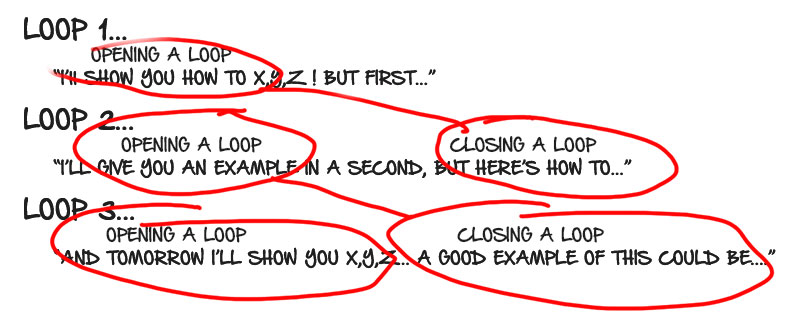Today I’m talking about an NLP technique called loops.
You can use these to increase your conversion rate, increase engagement with your audience, and it NLP loops also makes it easier for you to embed commands in your sales copy.
I’m gonna tell you all about loops and how you can use them but first how do they work?
Well I’m gonna give you an actual example in a few minutes, but first…
We’ve actually got two types of loops that you can use; loops and nested loops.
I’ll tell you more about both of them in a second, but how do they work?
Table of Contents:
How do NLP Loops Work?
They pull in your readers, listeners, or viewers deeper into your message, keep them interested and engaged with your content.
In fact loops put your audience into a minor state of trance – and that is that’s not as complicated or as weird as it sounds.
We actually go into minor trance states multiple times every day.
Often when we do things on autopilot, for example when you tie your shoelaces, most of that routine is done on autopilot and therefore in a very slight trance state.
We can use loops in a similar way to hook people in.
And because they’re in a state of trance, to some degree, their suggestibility levels will increase.
That also allows to embed commands more efficiently.
Now, I’m actually gonna show you how to make your own NLP loops in this post.
I’m gonna pretty much guarantee that you have already seen these kind of NLP loops in action.
NLP Loops are Everywhere
Just think about your favorite TV shows.
Think about the epic cliffhanger ending.
TV shows are designed to they leave you in a state of suspense and curiosity.
The make you feel the desire for closure.
And that in itself is a loop.
They don’t finish the full story, they keep you in a state of suspense so you will tune in the next week.
And that’s the sole purpose of cliffhangers.
But as I mentioned a second ago we’ve actually got two types of loops, the second type is called a nested loop.
NLP Nested Loops
Nested loops are stories within a story.
They can take your audience on a journey and they’re really good for transitional content.
You can even use them to move your prospects through emotional states.
For example, maybe your prospects are in a state of mind where they don’t believe something is possible. They are in a negative state of mind where they see that something is not possible for them.
You can use nested loops to transition them from that mindset to a mindset where they know it is possible and they believe they can achieve it.
In fact, if you look at most stories, most films, and fictional books, they use a 3 act story packed with nested loops.
I’ve actually covered 3 act stories in a video. If you’re interested in that it might be worth checking out that video here.
Anyway, a lot of stories use the nested loop structure purely make sure that audiences become engaged and they commit on a subconscious level.
We can use the same thing in our storytelling, or in the content you create, or you can use it in your sales copy, in videos, in emails, and even in blog posts.
I will show you how to do that and how to put that into action in a second, in fact I’m going to give you an example script that you can use.
But first, to do this properly you have to know a couple of things.
You gotta what your audience wants.
And you have to know the journey they need to take in order to get it.
Once you know what kind of results they want to obtain from your content you can use that knowledge to transition them from A to B, or wherever they need to go.
So how do you start?
The best starting point is with a promise.
List the benefits and the things that they will achieve if they commit to consuming your story or your content.
It’s essentially a big promise or an end result.
Then you can move into how or why something works and maybe provide examples for them.
And then finally you move into the actionable portion or the conclusion of your story.
Thats a very simple 3 act story that you can use to structure your content.
But I’m actually going to show you a little diagram that I’ve made to help explain how nested loops work.
Making NLP Nested Loops
Here’s a rough diagram to help you understand the idea of nested loops.

The statement says:
I’ll show you how to X,Y, and Z! But first…
I’ll give you an example in a second but here’s how to…
And tomorrow I’ll show you X,Y, and Z . A good example of this could be…
You can modify this and edit it however you need to, but this is a very quick very loose structure that I’ve just come up with literally a few seconds ago.
How this works:
The first sentence opens the loop.
The second sentence opens a second loop, while closing the first loop.
And then the last sentence opens a third loop, while closing the second loop.
Hopefully you can see how nested loops flow and get the basic structure.
It’s fairly simple once we see it drawn out in a diagram.
So there you go, I hope you found this useful and use it to increase your conversion rate and engagement.
If you have found it useful then share it with others who might benefit from it too, and they’ll probably be thankful to you as a result.
Image credit: Darkday
